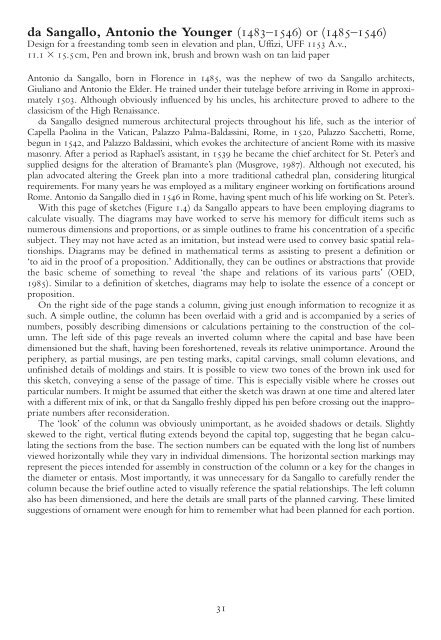Architect Drawings : A Selection of Sketches by World Famous Architects Through History
Create successful ePaper yourself
Turn your PDF publications into a flip-book with our unique Google optimized e-Paper software.
da Sangallo, Antonio the Younger (1483–1546) or (1485–1546)<br />
Design for a freestanding tomb seen in elevation and plan, Uffizi, UFF 1153 A.v.,<br />
11.1 15.5cm, Pen and brown ink, brush and brown wash on tan laid paper<br />
Antonio da Sangallo, born in Florence in 1485, was the nephew <strong>of</strong> two da Sangallo architects,<br />
Giuliano and Antonio the Elder. He trained under their tutelage before arriving in Rome in approximately<br />
1503. Although obviously influenced <strong>by</strong> his uncles, his architecture proved to adhere to the<br />
classicism <strong>of</strong> the High Renaissance.<br />
da Sangallo designed numerous architectural projects throughout his life, such as the interior <strong>of</strong><br />
Capella Paolina in the Vatican, Palazzo Palma-Baldassini, Rome, in 1520, Palazzo Sacchetti, Rome,<br />
begun in 1542, and Palazzo Baldassini, which evokes the architecture <strong>of</strong> ancient Rome with its massive<br />
masonry. After a period as Raphael’s assistant, in 1539 he became the chief architect for St. Peter’s and<br />
supplied designs for the alteration <strong>of</strong> Bramante’s plan (Musgrove, 1987). Although not executed, his<br />
plan advocated altering the Greek plan into a more traditional cathedral plan, considering liturgical<br />
requirements. For many years he was employed as a military engineer working on fortifications around<br />
Rome. Antonio da Sangallo died in 1546 in Rome, having spent much <strong>of</strong> his life working on St. Peter’s.<br />
With this page <strong>of</strong> sketches (Figure 1.4) da Sangallo appears to have been employing diagrams to<br />
calculate visually. The diagrams may have worked to serve his memory for difficult items such as<br />
numerous dimensions and proportions, or as simple outlines to frame his concentration <strong>of</strong> a specific<br />
subject. They may not have acted as an imitation, but instead were used to convey basic spatial relationships.<br />
Diagrams may be defined in mathematical terms as assisting to present a definition or<br />
‘to aid in the pro<strong>of</strong> <strong>of</strong> a proposition.’ Additionally, they can be outlines or abstractions that provide<br />
the basic scheme <strong>of</strong> something to reveal ‘the shape and relations <strong>of</strong> its various parts’ (OED,<br />
1985). Similar to a definition <strong>of</strong> sketches, diagrams may help to isolate the essence <strong>of</strong> a concept or<br />
proposition.<br />
On the right side <strong>of</strong> the page stands a column, giving just enough information to recognize it as<br />
such. A simple outline, the column has been overlaid with a grid and is accompanied <strong>by</strong> a series <strong>of</strong><br />
numbers, possibly describing dimensions or calculations pertaining to the construction <strong>of</strong> the column.<br />
The left side <strong>of</strong> this page reveals an inverted column where the capital and base have been<br />
dimensioned but the shaft, having been foreshortened, reveals its relative unimportance. Around the<br />
periphery, as partial musings, are pen testing marks, capital carvings, small column elevations, and<br />
unfinished details <strong>of</strong> moldings and stairs. It is possible to view two tones <strong>of</strong> the brown ink used for<br />
this sketch, conveying a sense <strong>of</strong> the passage <strong>of</strong> time. This is especially visible where he crosses out<br />
particular numbers. It might be assumed that either the sketch was drawn at one time and altered later<br />
with a different mix <strong>of</strong> ink, or that da Sangallo freshly dipped his pen before crossing out the inappropriate<br />
numbers after reconsideration.<br />
The ‘look’ <strong>of</strong> the column was obviously unimportant, as he avoided shadows or details. Slightly<br />
skewed to the right, vertical fluting extends beyond the capital top, suggesting that he began calculating<br />
the sections from the base. The section numbers can be equated with the long list <strong>of</strong> numbers<br />
viewed horizontally while they vary in individual dimensions. The horizontal section markings may<br />
represent the pieces intended for assembly in construction <strong>of</strong> the column or a key for the changes in<br />
the diameter or entasis. Most importantly, it was unnecessary for da Sangallo to carefully render the<br />
column because the brief outline acted to visually reference the spatial relationships. The left column<br />
also has been dimensioned, and here the details are small parts <strong>of</strong> the planned carving. These limited<br />
suggestions <strong>of</strong> ornament were enough for him to remember what had been planned for each portion.<br />
31




